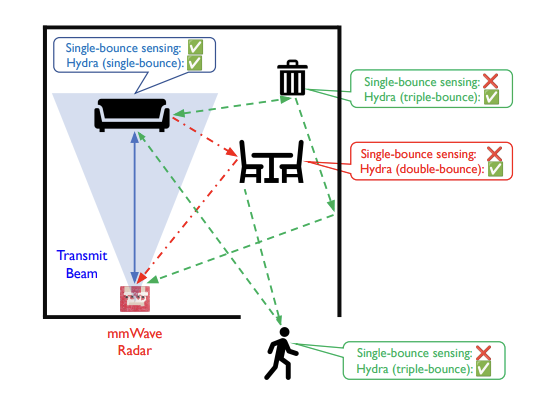The mDOT Center
Transforming health and wellness via temporally-precise mHealth interventions






mDOT@MD2K.org
901.678.1526
901.678.1526








Collaborating Investigator:
Dr. Ashutosh Sabharwal (PI), Rice University
Funding Status:
NSF/IIS
3/1/18 – 2/28/23
Associated with:

Proceedings of the 30th Annual International Conference on Mobile Computing and Networking
December 4, 2024
millimeter-wave, multi-bounce scattering, radar, sensing, beyond-field-of-view, localization.
In this paper, we ask, “Can millimeter-wave (mmWave) radars sense objects not directly illuminated by the radar – for instance, objects located outside the transmit beamwidth, behind occlusions, or placed fully behind the radar?” Traditionally, mmWave radars are limited to sense objects that are directly illuminated by the radar and scatter its signals directly back. In practice, however, radar signals scatter to other intermediate objects in the environment and undergo multiple bounces before being received back at the radar. In this paper, we present Hydra, a framework to explicitly model and exploit multi-bounce paths for sensing. Hydra enables standalone mmWave radars to sense beyond-field-of-view objects without prior knowledge of the environment. We extensively evaluate the localization performance of Hydra with an off-the-shelf mmWave radar in five different environments with everyday objects.
“Hydra” is a novel framework that significantly enhances millimeter-wave (mmWave) radar capabilities by exploiting multi-bounce scattering to sense objects located beyond the radar’s direct field-of-view (FoV). This includes objects that are not directly illuminated, are behind occlusions, or are even completely behind the radar unit. Unlike traditional single-bounce radar methods, Hydra operates without requiring prior knowledge of the environment or additional hardware. It employs a sequential detection and localization process, using earlier single-bounce detections as anchors to find objects via double and triple bounces. Tested on a commercial mmWave MIMO radar, Hydra demonstrates a 2× to 10× improvement in median beyond-FoV localization error for human targets compared to conventional single-bounce techniques.
Imaging of human body at cellular-level at various depths below the skin can fundamentally impact healthcare by providing live views of cross sections of anatomy. However, current methods to achieve cellular resolution are invasive (e.g. tissue biopsy). SP6 is developing computational imaging sensors for non-invasive, deep below the skin, and at cellular-level resolutions. These sensors will enable bio-imaging deep below the skin simply by pointing a camera at any part of the body. This would put individual users at the center of their healthcare experience and make them true partners in their healthcare delivery. The health imaging devices that result from this project will act as an important pillar in the personalized medicine revolution. This research expedition also holds the potential to launch new healthcare paradigms for chronic disease management, pediatrics, low-resource healthcare, and disaster medical care.
The development of new high rate sensors, able to capture the data necessary to reconstruct the structure of the tissue deep below the skin, constitutes the most important contribution of the project. These systems and algorithms will have the potential to break the current resolution limits of noninvasive bio-imaging by nearly two orders of magnitude, enabling cellular-level imaging at depths far beyond currently possible.
SP6 is developing next generation high rate sensors that needs to be integrated into mobile health infrastructure for the users to participate in their healthcare delivery effectively. TR&D3 Aim 2 will share hardware/software co-designs for high rate sensing and embedded biomarker computations with SP6 to serve as digital backends to integrate novel sensing systems developed by SP6 into mobile health workflow. In addition, machine learning algorithms developed by TR&D3 under Aim 1 for automated discovery of micromarker will be disseminated to SP6 for developing computationally-efficient version of the new biomarkers enabled by the new imaging modalities pioneered by SP6.
You must be logged in to post a comment.

No Comments